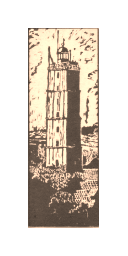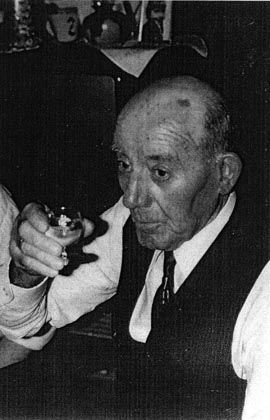
Hinne de Jong
A Chronicle
translated/arranged by his son, Sense de Jong
The story of Captain Pieter de Jong
- 1: Introduction
- 2: Captain Pieter
- 3: Childhood years
- 4: Shipwreck
- 5: Teenager
- 6: Spring remembered
- 7: That's how it was
- 8: Pre World War I
- 9: Mobilization (1914-1918)
- 10: Boys will be boys
- 11: Hinne leaves Terschelling
- 12: Hinne meets his true love
- 13: An eventful move
- 14: A serious illness
- 15: The war years (1940-1945)
- A1: Memories of Pa (by Truus)
- A2: Memories of Moe (by Truus)
- A3: Pa talks again
- A4: Cornelis Jacob de Jong
Another site by Sense de Jong:
~ Sense de Jong ~
Reminiscences
Sites by Henry de Jong:
~ Herman de Jong ~
Memorial
~ Newmaker Notes~
Writings, Pictures, Collections
~ AACS/ICS Niagara Conferences~
1970 - 1991
My father, Hinne de Jong, had a five-year older brother called Pieter, to us Oom Piet. These two, Hinne and Piet, were the only de Jong boys who sought a career off the island of Terschelling. Hinne became an official with the Arnhem-based "Nederlandse Heide Maatschappij" (a Dutch crown corporation involved in land reclamation and reforestation). Oom Piet, in 1904, started a career with the Rotterdam-based "Scheepvaart en Steenkolen Maatschappij" (S.S.M.), a coal shipping company.
Oom Piet, like my father, has left a written record behind about his early days and subsequent experiences. The story that follow: "The sinking of the s.s. 'Friesland'," is an actual translation of Oom Piet's account of his narrow escape from death during WW II.
During March, 1904, having completed his elementary education, Oom Piet (then only 13 years of age!), became a young helper on a merchant sailing-boat. In 1907, he signed on as messboy on the s.s. "Danae." From 1907-1910 he was an ordinary seaman (matroos) on a number of South America Line ships: the s.s. "Maasland," the s.s. "Amstelland." and the s.s. "Zaanland." He sailed on various other ships until called upon to serve briefly in the Royal Dutch Navy.
He entered Navigation School during the fall of 1913 and obtained his diploma in 1914. In July of that year he started his S.S.M. career as second mate on the s.s. "Zeeland." WWI started and during mobilisation he served on Terschelling under a captain with the Royal Dutch Navy. He was very fortunate: he was close to home.
He left the Navy in 1916 and immediately signed on as second mate on the s.s. "Gaasterland." The captain of this ship, a certain J. Bloem, and another second mate, Nico Ree, were all native Terschellingers. Oom Piet was promoted to first mate shortly thereafter. They made trips to England and often joined English ships in convoy. He saw many of those ships go down as a result of the horrors of WW I.
In 1918 he went back to Navigation School on Terschelling. He was a student when the move took place to the famous "Willem Barendts Zeevaartschool," a newly-built school erected close to West Terschelling. ( When approaching Terschelling from the sea, you can see the school from far away.) However, due to the Spanish flu epidemic, starting the actual classes was somewhat delayed.
During 1918, he wrote his Second Officer exams in The Hague. Leaving the island for The Hague, some of his buddies in the harbour told him it was no use, he'd never make it. But make it he did. He returned triumphantly with his diploma in his pocket!
He got his First Officer papers during the next year. From 1919-1921 he was Number One on the s.s. "Schieland" and then the s.s. "Hoogland." And, on August 11, 1921, he became captain of the latter ship. He had reached his goal. From now on he was Captain de Jong!
At the start of WW II he was captain of the s.s. "Friesland" and with this ship made journeys along the English coast, to Canada and to West Africa. On October 27, 1941, it was sunk by the Germans in the North Sea (see following story). After his recuperation in England, Captain de Jong was asked to command another ship.
Oom Piet was honoured in 1943 by Queen Wilhelmina in London. She presented him with the Meritorious Service Cross. Later that year, the Dutch Minister of the Navy bestowed on him the rank of Lieutenant First Class for Special Services (temporary).
During the remainder of the war he joined the Pilotage out of Ostende (Belgium) and, later, Terneuzen (the Neth.). After WW II he was again engaged by the S.S.M. as captain of various ships. His last ship was the newly-built m.s. "Friesland."
On June 21, 1951, 47 years after starting his first job on a sailing-ship, Oom Piet went into retirement. He and Tante Alie took up residence in the modern home built on the former de Jong homestead. Address: Willem Barendts Kade 34, West Terschelling.
Oom Piet died on February 22, 1978, and is buried in the cemetery in the dunes of his beloved island

(1891-1978)
What follows is his story about the sinking of his ship in the North Sea.
The sinking of the s.s."Friesland" (October 27, 1941)
by Pieter de Jong (translated by Sense de Jong)
Departed from Dagenham (near London, England - sdj) at 0915 on October 25, 1941. Destination: Blyth (near Newcastle-upon-Thyne). Anchor down at 1230 near the coast of Southend, waiting for convoy instructions. Anchor up and left at 0730 on October 26, and joined the convoy. Pilot left ship at 1100. Weather forecast: showers and squalls. Passed the Sunk buoy at 1700.
On October 27: rainy weather, turbulent seas, force 5 northerly winds, visibility eight to 10 miles. Detected an aircraft at 1100 coming from the east at an altitude of about 100 meters. It flew right across the entire convoy but did not attack. Coming near the English coast it gained altitude, turned around and flew back at us. This time it released some bombs, which fell in the middle of the convoy but failed to do any damage. Flying back and forth at about six miles outside the convoy, it eventually disappeared towards the east when English fighter aircraft appeared on the scene.
At about 1400 detected four Dornier planes (German dive-bombers) coming at us from the east. Altitude: about 150 meters above sea level. I noticed one of the bombers leaving formation and preparing to dive-bomb us. All machine guns on deck, as well as the Holman projector, were manned and blazing away.
Notwithstanding our heavy anti-aircraft fire, the Dornier released five mid-sized bombs. Two bombs fell down the smoke stack, straight into the engine room. Two bombs went into hold No. 4, and the last bomb hit the fo'c'sle, bounced off the deck and fell into the sea where it exploded.
The ship began to sink immediately. Both lifeboats were damaged and rendered useless. The crew was able to throw the port side raft overboard. At this time the deck was even with the sea level. The ship began to go down by the stern, whereupon it stood straight up in the water. All of this happened in a few minutes. (The ship stayed in that position for nearly an hour until an air gunner aboard a British destroyer gave it de "coup de grace.")
I tried to get a hold of the ship's log and papers, but had to give up, since I was now waistdeep in the water and was in grave danger of being sucked down with the ship. I also need to explain that I had never mastered the art of swimming. But I was wearing a life jacket. I found myself caught under the bridge. Fortunately, two wooden shutters were floating nearby. I grabbed them and with a shutter under each arm I managed somehow to get from under that bridge. However, once free, I started to float dangerously towards the keel of the ship, now standing vertically in the water.
Another person came to the surface nearby. I didn't recognize him because he was as black as a chimney sweep. Evidently, a bomb exploded in the bunker because the water was covered with a thick layer of coal dust. I never saw that person again. Meanwhile, due to the current and the wind, I kept floating towards the doomed ship.
Suddenly, I noticed a wooden cabinet, floating high in the water, coming towards me. I recognized it as having stood somewhere on the bridge. Letting go of one of the shutters, I managed to put my free arm around that cabinet. And that's how I succeeded in getting away from the sinking ship. Some distance away, I saw some people on top of an overturned sloop. Also, some survivors clung onto the raft, eventhough it had split in half because of the explosions. And there was I...alive and kicking!
The other convoy ships passed close by us. I yelled for help, but I knew those ships were not allowed to stop. But I had been noticed! Other survivors were waiving their arms and I heard their voices.
After drifting around in the cold water for about an hour, an English warship noticed me and edged itself closer to me. They threw a line, but I couldn't grab it. Another line was thrown and, this time, it ended up over my shoulder. Letting go of the cabinet and the shutter I grabbed onto it with all my strength. They drew me alongside and motioned for me to grab the safety net which had been thrown over the side. But I was too weak. Some sailors climbed down and pulled me upwards onto the deck of that ship. I can still hear them yell :"We've got the captain!" Then they poured some whiskey down my throat and took me to the hot showers. When I looked in the mirror, I noticed that I, too, was pitch-black. While in the shower, I heard someone speak Dutch in the stall next to me. It was the voice of my chief mate Akkerman.
We were brough to the harbour of Great Yarmouth and went ashore there. Of the 25 aboard the s.s. "Friesland," twelve sailors lost their lives in this disaster.
(End of Oom Piet's story)
[an error occurred while processing this directive]